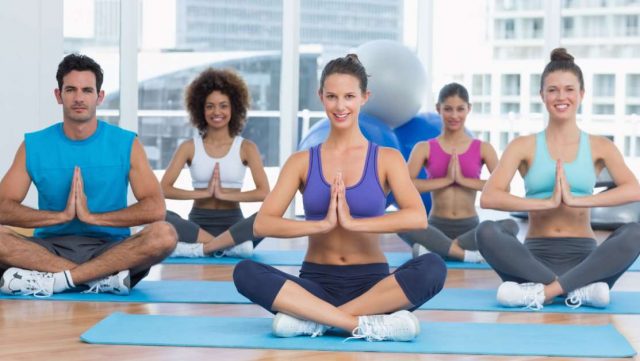Yoga and meditation are two effective practices for finding inner peace, reducing stress, and cultivating mindfulness. Both of these advantages can be yours if you practice them regularly. Even though each of these activities has the potential to effect change on its own, when combined, they have a far greater impact.
It is commonly stated that practicing yoga is an excellent way to prepare both the mind and the body for meditation, making it much easier to achieve a sense of calm and clarity.
In this article, we’ll look at ten ways that incorporating yoga into your meditation practice can benefit your practice.
1. Improved Breathing
Breathwork is an essential part of both yoga and meditation, and it is one of the most important aspects of both. Through yoga practice, you can learn to control your breathing better and expand the capacity of your lungs. This will make it much easier for you to concentrate and maintain focus while practicing other types of meditation. Pranayama and ujjayi breathing, which both emphasize deep breathing, can help you breathe more deeply and calmly, allowing you to relax and release tension in your body. Yoga poses that emphasize deep breathing can be beneficial.
2. Boost Your Posture
Yoga and meditation both require you to maintain a proper posture throughout the practice. Yoga practice can help you improve your posture, which will make it easier for you to sit in a comfortable position while you meditate. You can improve your ability to meditate by practicing yoga poses that focus on spinal alignment and developing good posture habits. Mountain pose, downward dog pose, and warrior 1 pose are some examples of these poses.
3. Improve Your Ability to Concentrate
Focus and concentration are two skills that can be greatly improved by practicing yoga. Learning to tune out distractions and stay present in the moment is a skill that can come in handy during meditation. Yoga, which is a type of exercise, can help you learn these skills. Yoga poses that require balance and concentration, such as the tree pose, eagle pose, and dancer’s pose can help you improve your mental focus and concentration.
4. Reduce Your Anxiety and Stress Levels
Yoga and meditation are both excellent methods for reducing stress and anxiety in those who practice them. Through yoga practice, one can learn to relax the muscles of the body and mind, making it much easier to enter a meditative state characterized by feelings of calm and contentment within oneself. Yoga poses that can help relieve stress and promote relaxation include the child’s pose, the corpse pose, and the seated forward fold.
5. Increase Your Self-Awareness
Yoga can help you gain a better understanding of your body and mind, and it is also a great way to increase your self-awareness. Through yoga practice, you will become more attuned to your body and its needs, making it much easier to listen to your intuition while meditating. Yoga positions that can help you become more self-aware include camel pose, savasana, and seated meditation.
6. Increase Your Mindfulnes.
Yoga and meditation both emphasize the importance of being present in the moment. Yoga can help you develop mindfulness and learn how to be present in the here and now. This is an important skill to cultivate because it can be useful during meditation. Sun salutations, warrior 2 pose, and eagle pose are all yoga poses that emphasize mindfulness.
7. Develop a Sense of Gratitude
Both yoga and meditation place a high value on the practice of gratitude. Yoga can help you develop a sense of gratitude and appreciation for your body and its abilities. This will make it much easier to stay present and grateful while practicing meditation. Certain yoga postures, such as upward-facing dog, camel pose, and wheel pose, are known to open the heart and promote feelings of gratitude.
8. Relax the Muscle Tension in Your Body
Yoga can help release tension and tightness in your body, making it easier for you to sit still and concentrate when you meditate. Regular yoga practice can help you stretch and release the muscles in your back, neck, shoulders, and hips. This will make it much easier for you to sit comfortably while practicing meditation. Yoga poses that help release tension include the seated forward fold, the reclining twist, and the pigeon pose.
9. Increase Your Energy Level
Yoga can help you feel more energized and promote mental clarity, both of which will help you focus when you meditate. Yoga practice can improve the flow of blood to the brain and stimulate the release of endorphins, both of which can contribute to an improvement in your mood and energy level. Sun salutations, Warrior 1 pose, and Bridge Pose are all examples of energy-boosting yoga poses.
10. Encourage Calm
Finally, yoga has been shown to aid in the development of a sense of calm and inner peace, making it easier to enter a meditative state. When you practice yoga, you can stimulate your parasympathetic nervous system, which is in charge of the body’s relaxation response. Forward folds, child’s pose, and legs up the wall are three yoga poses that can help you relax.
Conclusion
If you want to improve your meditation practice or find ways to cultivate inner peace and well-being in your life, incorporating yoga into your daily routine can be a game-changer. Yoga can help improve your breathing, posture, and focus; it can also help reduce stress and anxiety; it can help increase self-awareness; it can help improve mindfulness; it can help cultivate gratitude; it can promote energy and calm; and it can help release tension. Regular yoga practice can help you build a strong foundation for your meditation practice and reap the many benefits that come with it. This is one of the numerous advantages of yoga. Get your yoga mat, find a quiet place to meditate, and prepare for a life-changing experience courtesy of the power of yoga and meditation!

Speaks from heart, always too passionate and driven by emotions. Spins the words with kindness & sharpness, intriguing your ever-inscrutable minds.




